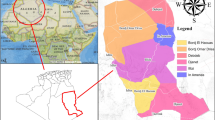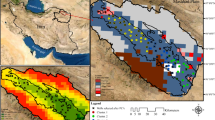Abstract
Monsoon floods are recurring hazards in most countries of South-East Asia. In this paper, a wavelet transform-genetic algorithm-neural network model (WAGANN) is proposed for forecasting 1-day-ahead monsoon river flows which are difficult to model as they are characterized by irregularly spaced spiky large events and sustained flows of varying duration. Discrete wavelet transform (DWT) is employed for preprocessing the time series and genetic algorithm (GA) for optimizing the initial parameters of an artificial neural network (ANN) prior to the network training. Depending on different inputs, four WAGANN models are developed and evaluated for predicting flows in two Indian Rivers, the Kosi and the Gandak. These rivers are infamous for carrying large flows during monsoon (June to Sept), making the entire North Bihar of India unsafe for habitation or cultivation. When compared, WAGANN models are found to be better than autoregression models (ARs) and GA-optimized ANN models (GANNs) which use original flow time series (OFTS) for inputs, in simulating river flows during monsoon. In addition, WAGANN models predicted relatively reasonable estimates for the extreme flows, showing little bias for underprediction or overprediction.







Similar content being viewed by others
References
Adamowski JF (2008) River flow forecasting using wavelet and cross-wavelet transform models. Hydrolo Process 22:4877–4891
Adamowski JF, Sun K (2010) Development of a coupled wavelet transform and neural network method for flow forecasting of non-perennial rivers in semi-arid watersheds. J Hydrol 390:85–91
Addison PS, Murray KB, Watson JN (2001) Wavelet transform analysis of open channel wake flows. J Eng Mech 127(1):58–70
ASCE (Task Committee on Application of Artificial Neural Networks in Hydrology (2000b) Artificial neural networks in hydrology II: hydrologic applications. J Hydraulic Eng ASCE 5:123–137
ASCE (Task Committee on Application of Artificial Neural Networks in Hydrology) (2000a) Artificial neural networks in hydrology I: preliminary concepts. J Hydraul Eng ASCE 5:115–123
Chau KW, Wu CL, Li YS (2005) Comparison of several flood forecasting models in Yangtze River. J Hydrol Eng 10:485–491
Coulibaly P, Burn HD (2004) Wavelet analysis of variability in annual Canadian streamflows. Water Resour Res 40, W03105. doi:10.1029/2003WR002667
Deb K (2001) Multi-Objective optimization using evolutionary algorithms. John Wiley and Sons Asia
FMIS (2012) Flood management information system. Water Resources Department, Patna
Goldberg DE (1989) Genetic algorithms in: Search, optimization and machine learning. Addison-Wesley, New York
International Federation of Red Cross and Red Crescent Societies (2006) Geneva, Switzerland: World Disaster Report, p 12
Kisi O (2008) Stream flow forecasting using neuro-wavelet technique. Hydrol Processes 22:4142–4152
Kisi O (2009) Neural networks and wavelet conjunction model for intermittent streamflow forecasting. J Hydrol Eng 14:773–782
Kisi O (2010) Wavelet regression model for short-term streamflow forecasting. J Hydrol 389:344–353
Kisi O (2011a) A combined generalized regression neural network wavelet model for monthly streamflow prediction. KSCE J Civil Eng 15(8):1469–1479
Kisi O (2011b) Wavelet regression model as an alternative to neural networks for river stage forecasting. Water Resour Manag 25:579–600
Kisi O, Shiri J (2011) Precipitation forecasting using wavelet-genetic programming and wavelet-neuro-fuzzy conjunction models. Water Resour Manag 25:3135–3152
Kisi O, Shiri J (2012) Discussion on precipitation forecasting using wavelet-genetic programming and wavelet-neuro-fuzzy conjunction models. Water Resour Manag. doi:10.1007/s 11269-012-0060-y
Kucuk M, Agiralioglu N (2006) Wavelet regression techniques for stream flow predictions. J Appl Stat 33:943–960
Labat D, Ababou R, Mangin A (2000) Rainfall-runoff relation for karstic spring, part 2: continuous wavelet and discrete orthogonal multi resolution analyses. J Hydrol 238:149–178
Maier HR, Dandy GC (2000) Neural networks for the predication and forecasting of water resources variables: a review of modelling issues and applications. Environ Model Softw 15:101–124
Mallat SG (1989) A theory for multi resolution signal decomposition: the wavelet representation. IEEE Trans Pattern Anal Mach Intel 11:674–693
Michalewicz Z (1992) Genetic algorithm + data structures = evolutionary programs. Springer, New York
Moosavi V, Vafakhah M, Shirmohammadi B, Behnia N (2013) A wavelet-ANFIS hybrid model for groundwater level forecasting for different prediction periods. Water Resour Manag 27:1301–1321
Partal T, Kucuk M (2006) Long-term trend analysis using discrete wavelet components of annual precipitations measurements in Marmara region (Turkey). Phys Chem Earth 31:1189–1200
Rajaee T (2011) Wavelet and ANN combination model for prediction of daily suspended sediment load in rivers. Sci Total Env 409:2917–2928
Rajaee T, Nourani V, Kermani MZ, Kisi O (2010) River suspended sediment load prediction: application of ANN and wavelet conjunction model. J Hydrol Eng 16(8):613–627
Ramana RV, Krishna B, Kumar SR SR, Pandey NG (2013) Monthly rainfall prediction using wavelet neural network analysis. Water Resour Manage 27:3697–3711
Sahay RR, Chakraborty A (2012) Predicting river floods using discrete wavelet. J Soil Water Sci IV 1:29–41
Sahay RR, Sehgal V (2013) Wavelet regression models for predicting flood stages in rivers: a case study in Eastern India. J Flood Risk Manag 6:146–155
Shiri J, Kisi O (2010) Short-term and long-term streamflow forecasting using a wavelet and neuro-fuzzy conjunction model. J Hydrol 394:486–493
Smith LC, Turcotte DL, Isacks B (1998) Stream flow characterization and feature detection using a discrete wavelet transform. Hydrol Process 12:233–249
Taormina R, Chau KW, Sethi R (2012) Artificial neural network simulation of hourly groundwater levels in a coastal aquifer system of the Venice lagoon. Eng Appl Artif Intel 25:1670–1676
Tiwari MK, Chatterjee C (2010) Development of an accurate and reliable hourly flood forecasting model using wavelet-bootstrap-ANN (WBANN) hybrid approach. J of Hydrol 394:458–470
Wang W, Ding J (2003) Wavelet network model and its application to the prediction of the hydrology. Nat Sci 1:67–71
Wang W, Jin J, Li Y (2009) Prediction of inflow at Three Gorges Damin Yangtze river with wavelet network model. Water Resour Manag 23:2791–2803
Wu CL, Chau KW (2006) Evaluation of several algorithms in forecasting flood. Adv Appl Artif Intell 4031:111–116
Wu CL, Chau KW, Li YS (2009) Predicting monthly streamflow using data-driven models coupled with data-preprocessing techniques. Water Resour Res 45, W08432. doi:10.1029/2007WR006737
Zhou HC, Peng Y, Liang GH (2008) The research of monthly discharge predictor-corrector model based on wavelet decomposition. Water Resour Manag 22:217–227
Acknowledgment
This research is supported by All India Council of Technical Education, New Delhi, India (F.N. 8023/BOR/RID/RPS-45/2007-8) and University Grants Commission, New Delhi, India (F.N. 33-482/2007).
Author information
Authors and Affiliations
Corresponding author
Appendix I
Appendix I
-
a.
Optimal values of weights and biases for the ANN (3,6,1), used in WAGANN3 and the GANN3 models (for the Gandak River)
-
(i)
Interconnection weights from hidden neurons to input neurons:
[15.4486 23.0843 -59.9149; 3.0532 11.5108 -4.9351;-5.928 4.5639 -3.3893;
−6.7051 12.8147 7.0374; 14.5115 21.3057 -57.6155;-0.4871 -5.4408 2.8422]
-
(ii)
Interconnection weights from hidden neurons to output neuron:
[14.0027 -2.3576 -3.0386 -8.3629 -14.2711 -6.3305]
-
(iii)
Bias to neurons in hidden layer:
[0.5931; -4.612; 1.6813; 1.2003; 0.9016; 0.7423]
-
(iv)
Bias to output neuron:
[12.474]
-
(i)
-
b.
Optimal values of weights and biases for the ANN (4,6,1), used in WAGANN4 and the GANN4 models (for the Kosi River)
-
(i)
Interconnection weights from hidden neurons to input neurons:
[0.65459 -12.61 5.0574 -2.6024; -0.83345 -12.7699 8.5516 -1.1088;
7.8724 -9.3901 -2.9088 -0.71956; 1.5982 0.87175 -1.8122 0.21225;
2.4736 -10.7611 0.69216 -2.1315; -18.0929 8.5845 -25.7407 48.061]
-
(ii)
Interconnection weights from hidden neurons to output neuron:
[15.6315 9.3779 -7.3199 38.6412 -14.6288 -9.0617]
-
(iii)
Bias to neurons in hidden layer:
[1.9931; 4.6363; 4.3863; -0.25541; 1.9696; 7.4002]
-
(iv)
Bias to output neuron:
[−13.6284]
-
(i)
Rights and permissions
About this article
Cite this article
Sahay, R.R., Srivastava, A. Predicting Monsoon Floods in Rivers Embedding Wavelet Transform, Genetic Algorithm and Neural Network. Water Resour Manage 28, 301–317 (2014). https://doi.org/10.1007/s11269-013-0446-5
Received:
Accepted:
Published:
Issue Date:
DOI: https://doi.org/10.1007/s11269-013-0446-5




